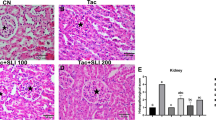Summary
It is known that total L-tryptophan (Trp) levels decrease with a decrease in albumin-bound Trp levels and an increase in free Trp levels in the plasma or serum of nephrotic children. We, therefore, examined the change of serum Trp levels following the development and recovery of acute nephrosis in 6-week-old male Wistar rats injected once with puromycin aminonucleoside (100mg/kg body weight) and checked the levels of 16 amino acids including Trp in the serum and the levels of Trp in the liver, kidney, and urine under nephrotic conditions. In this study, the development and recovery of nephrosis were checked by the changes of levels of urinary protein and serum protein and albumin. Total serum Trp and albumin-bound serum Trp levels decreased with the development of nephrosis and these decreased levels returned to the normal level with its recovery. In contrast, free serum Trp levels increased with the development of nephrosis and this increased level returned to the normal level with its recovery. In the serum of nephrotic rats, the decrease of albumin-bound Trp levels and the increase of free Trp levels were well consistent with a decrease in albumin levels and an increase in the level of non-esterified fatty acids which are known to weaken the binding of Trp to albumin and among 16 amino acids studied, only Trp showed a significant change in its levels. Trp levels increased in the liver and kidney but not in the urine under nephrotic conditions. These results indicate that the change of serum Trp levels should be closely related to the condition of nephrosis and that although serum Trp is lost under nephrotic conditions, the lost serum Trp is accumulated in the liver and kidney.
Similar content being viewed by others
References
Bender DA (1982) Biochemistry of tryptophan in health and disease. Mol Aspect Med 6: 101–197
Brodersen R, Vorum H, Skribver E, Pederson AO (1989) Serum albumin binding of palmitate and stearate. Multiple binding theory for insoluble ligands. Eur J Biochem 182: 19–25
Curzon G, Friedel J, Knott PJ (1973) The effect of fatty acids on the binding of tryptophan to plasma protein. Nature 242: 198–200
Curzon G, Friedel J, Katamaneni BD, Greenwood MH, Lader MH (1974) Unesterified fatty acids and the binding of tryptophan in human plasma. Clin Sci Mol Med 47: 415–424
Denckla WD, Dewey HK (1967) The determination of tryptophan in plasma, liver, and urine. J Lab Clin Med 69: 160–169
Diamond JR, Karnovsky MJ (1986) Focal and segemental glomerulosclerosis following a single intravenous dose of puromycin aminonucleoside. Am J Pathol 122: 481–487
Doumas BT, Watson A, Biggs HG (1971) Albumin standards and the measurement of serum albumin with bromcresol green. Clin Chim Acta 31: 87–96
Frenk S, Antonowicz I, Craig JM, Metcoff J (1955) Experimental nephrosis syndrome induced in rats by aminonucleoside. Renal lesions and body electrolyte composition. Proc Soc Exp Biol Med 89: 424–427
Fuller RW, Roush BW (1973) Binding of tryptophan to plasma proteins in several species. Comp Biochem Physiol 46B: 273–276
Fydryk J, Kurzawska O, Szuba W (1984) Serum tryptophan (Try) level and its binding capacity to albumin in nephrotic syndrome (SN). Int J Pediat Nephrol 5: 124
Gitlin D, Janeway CA, Farr LE (1959) Studies on the metabolism of plasma proteins in the nephrotic syndrome. I. Albumin, γ-globulin and iron-binding globulin. J Clin Invest 35: 44–56
Gornal AG, Bardawill CS, David MM (1949) Determination of serum protein by means of the biuret reaction. J Biol Chem 177: 751–766
Katz J, Bonorris G, Sellers AL (1963) Albumin metabolism in aminonucleoside nephrotic rats. J Lab Clin Med 62: 910–934
Katz J, Sellers AL, Bonorris G (1964) Effect of nephrectomy on plasma albumin catabolism in experimental nephrosis. J Lab Clin Med 63: 680–686
Lowry OH, Rosebrough MJ, Farr AL, Randall RJ (1951) Protein measurement with the Folin phenol reagent. J Biol Chem 193: 265–275
McMenamy RH, Lund CC, Oncley JL (1957) Unbound amino acid concentration in human blood plasmas. J Clin Invest 36: 1672–1679
McMenamy RH, Oncley JL (1958) The specific binding of L-tryptophan to serum albumin. J Biol Chem 233: 1436–1447
Peter T Jr (1985) Serum albumin. Adv Protein Chem 37: 161–245
Pirazzoli G, Casadio L, Rosini R, Gualandi S, Tazzari R, Corsini F (1983) Studio delle correlazioni fra triptofano, NEFA e albumina nella sindrome nefrosica. Boll Soc Ital Biol Sper 59: 1–7
Rothschild MA, Oratz M, Mongelli J, Fishman L, Schreibner SS (1969) Amino acid regulation of albumin synthesis. J Nutr 98: 395–403
Saito K, Sasaki E, Ohta Y, Nagamura Y, Ishiguro I (1986) Mode of L-tryptophan uptake into rat hepatocytes via trypsin-sensitive high-affinity transport system. Biochem Int 13: 873–883
Sasaki E, Saito K, Ohta Y, Ishiguro I, Nagamura Y, Shinohara R, Takahashi H, Tagaya O (1991) Specific binding of L-tryptophan to serum albumin and its function in vivo. Adv Exp Med Biol 294: 611–614
Sasaki E, Ohta Y, Shinohara R, Ishiguro I (1993a) Effect of albumin on the disappearance of L-tryptophan from the perfusate into isolated perfused rat livers. J Clin Biochem Nutr 15: 185–194
Sasaki E, Ohta Y, Shinohara R, Ishiguro I (1993b) Effect of serum fatty acid levels on disappearance of blood L-tryptophan in rats fed lard. J Jpn Soc Nutr Food Sci (Nippon Eiyo Shokuryo Gakkaishi) 46: 487–493
Sellers AL, Katz J, Rosenfeld S (1961) Plasma albumin catabolism in experimental nephrosis. Nature 192: 562–563
Author information
Authors and Affiliations
Rights and permissions
About this article
Cite this article
Sasaki, E., Ohta, Y., Shinohara, R. et al. Change of serum L-tryptophan levels following the development and recovery of acute puromycin aminonucleoside nephrosis in rats. Amino Acids 12, 353–361 (1997). https://doi.org/10.1007/BF01373015
Received:
Accepted:
Issue Date:
DOI: https://doi.org/10.1007/BF01373015




